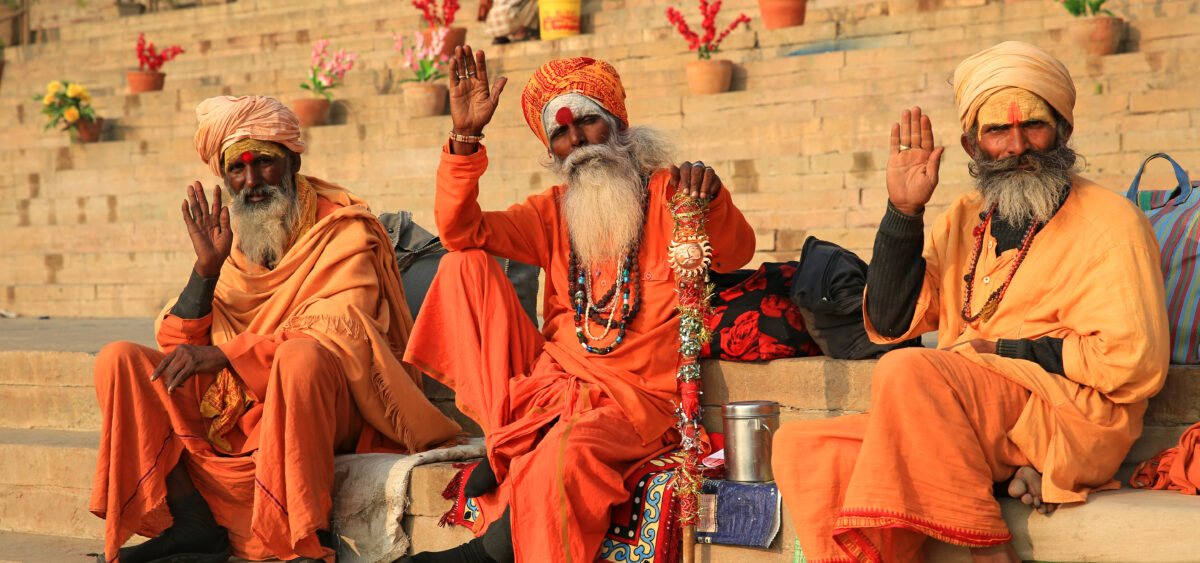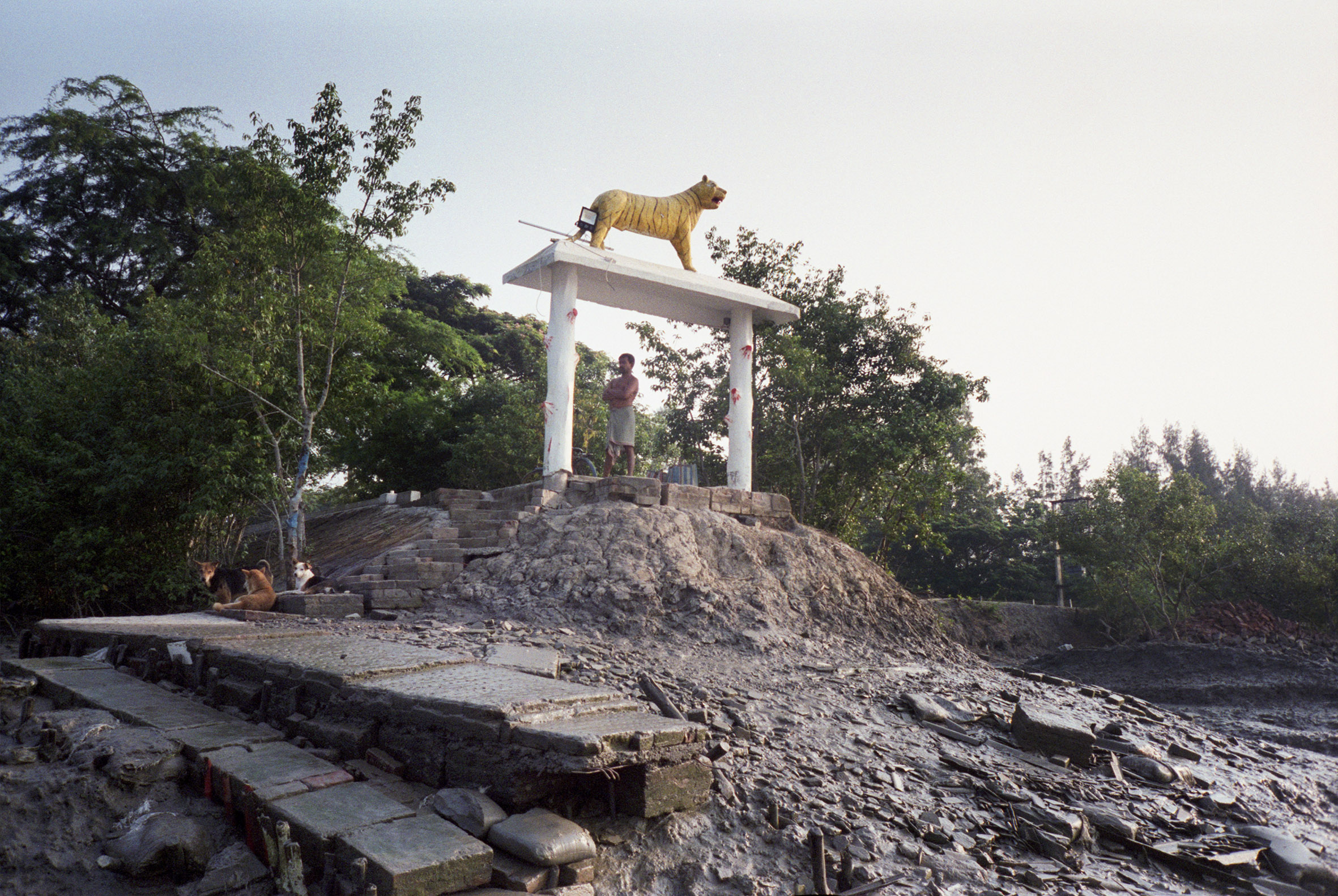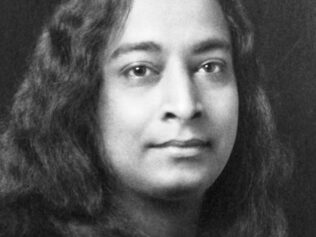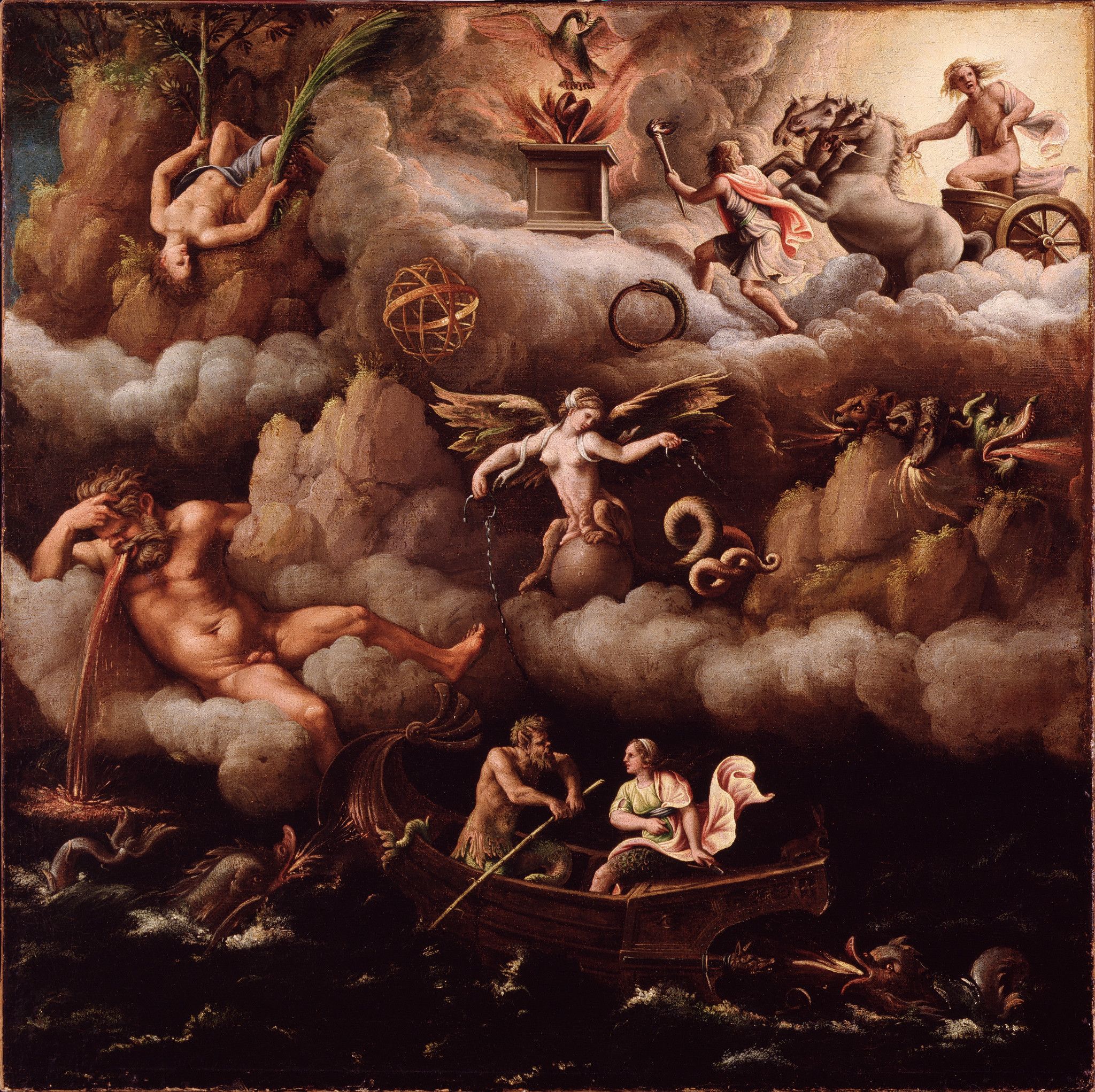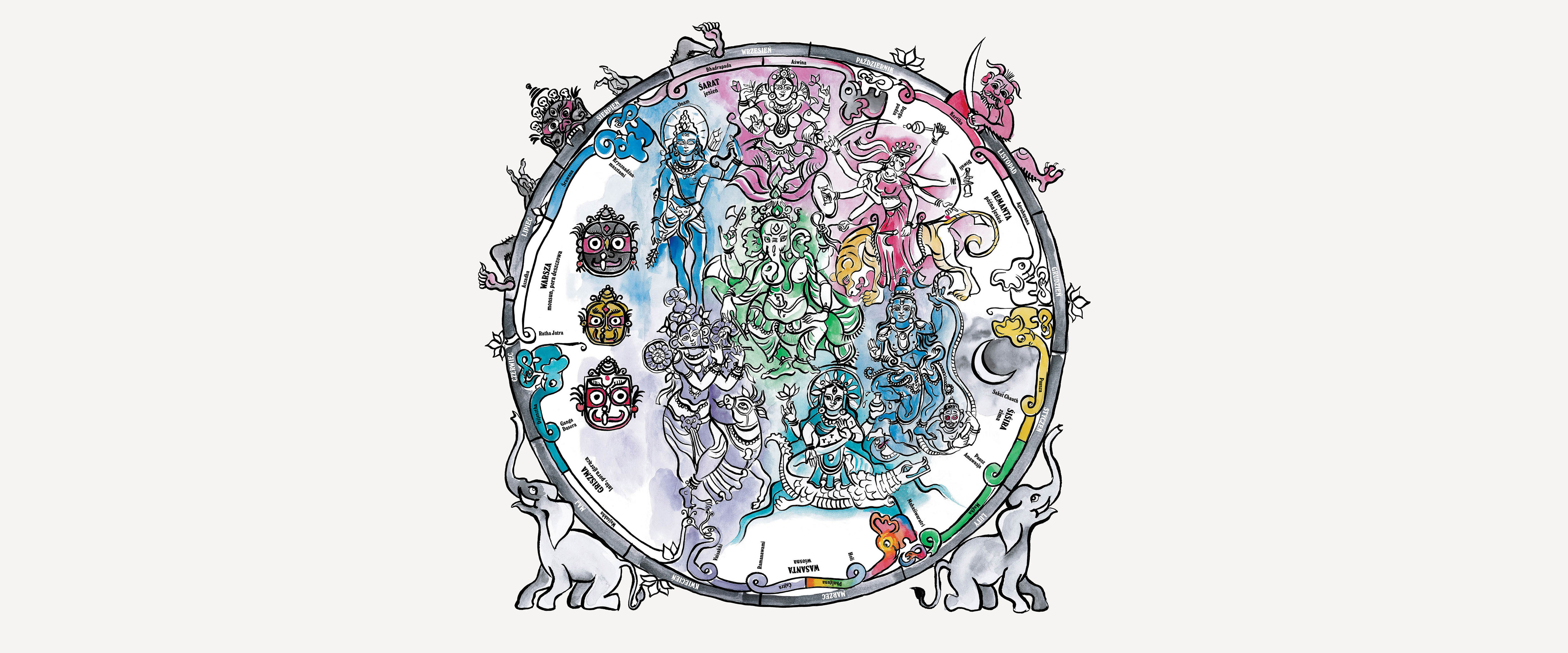
Hindus, Muslims, Buddhists, Sikhs, Jains, Christians, Zoroastrians, Jews, Baháʼís, eremites, teachers, holy men, charlatans… India’s religious spectrum is rich and diverse, and religion has an enormous impact on almost all areas of life.
Garlands of bright orange marigolds adorn the streets, massive billboards feature images of priests, ads for religious schools and meditation centers. I’m surrounded by thousands of people, and millions are present at this event. They are everywhere—on the sidewalks, clutching onto railings, climbing lampposts. Endless campsites surround the city. In Haridwar in the north of India—population two hundred thousand—there are currently five, six, or maybe even seven million pilgrims. Dressed in saffron robes, sadhus (from the Sanskrit: “good people”), ascetics, eremites, yogis. They came here to celebrate the Kumbh Mela (or the Pitcher Festival; kumbh refers to the vessel from which holy water is poured). It is the major celebration in Hinduism, record-breaking in terms of the number of participants, not only in India, but also around the globe. Suffice to say that during the 2001 Kumbh Mela, seventy million people celebrated in Allahabad (now Prayagraj), and eighteen years later this number went up to 120 million. It should be noted, however, that this is the total number of all pilgrims who passed through the city over two months. This is why the Kumbh Mela is known as the largest religious assembly in human history.
I follow the pilgrims towards the ghats, the concrete stairs on the waterfront, where they can take a cleansing dip in the water. They traveled here to seek forgiveness for their sins and atonement (prāyaścitta), to broaden their awareness and strengthen their willpower, and to finally begin a new chapter, a better life. Both the tirtha (place of pilgrimage) and the dip in the water are stages on the path to achieving moksha, i.e., liberation from saṃsāra—the cycle of birth and death. Importantly, the water used to wash the body must come from one of the sacred rivers: the Ganges, Jamuna, Godavari, Shipra, or the underground Sarasvati. The Kumbh Mela is celebrated alternately every twelve years in one of the four cities of Prayagraj, Haridwar, Ujjain, or Nashik, meaning that once every three years somewhere in India you can take a cleansing bath.
This ritual has a long history. Descriptions of similar practices can be found in ancient Vedic texts, including the famous epic poem Mahabharata. In it, one of the protagonists—submerged in despair and sadness following the great Kurukshetra War—travels to Prayagraj to atone and achieve peace of mind by bathing in the Ganges. Peace of mind, and also of the body—Indian writings feature descriptions of miraculous healings that took place during successive congregations. According to contemporary scholars of religion, these can be explained by a powerful unity forming within the community. In such circumstances, pilgrims tend to think in terms of “we” rather than “I,” which helps them to free themselves of some ailments. The very idea of the Kumbh Mela was born around the eighth century CE, and philosopher sadhu Adi Shankara is considered to be its creator. Shankara publicly declared the need for great gatherings of Hindus in order to purify themselves from sins, but also to experience intense theological discussions. However, there are no reports of similar events in pre-19th-century historical sources.
I cross a shaky bridge over the river, from where I can observe those performing ritual ablutions. From here, the Ganges looks different than in, for example, Varanasi, where its flow is slow and water spills over a width of several hundred feet in the rainy season. In Haridwar, the river is rather narrow and its current swift. Because of this, a fence was erected in the water, meaning that pilgrims aren’t swept away by its power. In the crowd, I watch more people jump into the water. The so-called naga sadhus: completely naked, ash-smeared holy men whose only “clothes” are marigold flower necklaces. Before they jump in the cold Ganges, they make faces, assume dangerous poses, and sometimes brandish their swords—symbols of dignity and power. It is easy to spot them during the Maha Shiwaratri ritual, “the night of Shiva,” which takes place on the day before the new moon—on the fourteenth day of the Magha month (in the Indian calendar this is the eleventh month of the year, starting in January and ending in February). The older naga sadhus bathe near the shore, holding on to the railings, the younger ones speedily swim away. Other pilgrims applaud them, repeat their mantras, sing, and fly orange flags and banners with the Om sign representing—in the Indian and Tibetan traditions—the sacred syllable, the first sound of the universe. Om symbolizes the breath of the Creator and offers the care of the highest forces. Meanwhile, the color orange symbolizes the search for inner light, sacrifice, and disavowal of one’s ego. It also conveys sexual purity and abstinence.
I hear people chant: “Hari, Mahadev!” Hari is another name of the god Vishnu, as well as his incarnation, Krishna, while Mahadev refers to the god Shiva. There are two statues of the latter near the Ganges. The larger one depicts him as a melancholy, pale youth with long, raven-black hair and carmine lips. According to Hindu mythology, he is the most powerful of the gods, the creator and destroyer, with 1,008 names. He is the one to whom the pilgrims of Haridwar pray most often, even though there are so many other Hindu deities that most would struggle to count them all.
The Trimurti—Vishnu, Shiva, and Brahma—are the most important deities. According to Hindu tradition, each of them plays a significant role: the third creates the universe, the first supports it, and the second destroys it. The pantheon also includes Krishna, Saraswati, Lakshmi, Durga, and Rama. There’s also the joyous Ganesha with the face of an elephant, Hanuman, resembling a monkey, and the bloodthirsty, woeful Kali. Their portraits can be found everywhere: on the facades of houses, in offices and workplaces, stadiums and universities, gas stations and canteens; they also feature on keychains and adornments in rickshaws and taxis. The gods are the patrons of hospitals and schools, but also shopping centers, tool shops, and ordinary grocery stores. Still, they all emanate the absolute, known in Hinduism as Brahman. Brahman rules the world and keeps it in check.
Faith in reincarnation—the migration of the soul—and respect for the sacred scriptures are commonplace. All the rest is interpreted quite freely. Hinduism is an assemblage of different traditions, devoid of a coherent doctrine or form of worship. It combines many philosophical concepts, although none of them is superior. Apart from the gods, there’s a belief in what surrounds us: holy rivers, mountains, trees, groves. In India, Hinduism isn’t even called Hinduism, but Sanatana Dharma, the eternal law. The Vedas—the sacred books written in Sanskrit four thousand years ago, which comprise the entire knowledge about the world of people and gods, are the symbol of a good life. What links Hinduism with many other religions is the idea of an immortal soul that applies to both humans and animals, plants and objects. Although the soul was created in the image of the gods, it differs from them in that it is still imperfect. Before it can achieve perfection (through moksha), it must pass through a series of incarnations (the wheel of saṃsāra). According to this idea, a human soul can be reborn in the body of a human infant, but also an animal or plant. Moksha can be achieved in three ways: through karma yoga (selfless activity), bhakti yoga (love and devotion), or djane yoga (achieving spiritual wisdom).
People worship gods in different ways—they pray in temples, go on pilgrimages to holy places, and make offerings. One ritual accompanies prayers to the goddess Kali, who is one of the incarnations of the wife of the god Shiva: Shakti. Her demonic face can be frightening—Kali is depicted as a figure with dark skin, with a red tongue, fangs, and many arms holding swords and daggers, as well as a wreath made of human heads. I watch the ritual dedicated to Kali in Kolkata (Kali is the city’s patron), in Kalighat district. Next door, there is a hospice founded by Mother Teresa, and a little further away Kolkata’s red-light district. In the mornings, in order to atone to the goddess and ensure prosperity, her followers slaughter a few goats. The all-powerful Kali controls human life in its entirety—from conception to death—and so deserves everything, including blood.
Hindus make up nearly four-fifths of India’s population, which translates into about a billion followers. Hinduism is the largest, though not the only, religion in the country. Nearly 14 percent of Indians are Muslims, almost 2.5 percent are Christians (thirty million), 1.7 percent are Sikhs (over twenty million). There are also Jains (about four million), Bahá’ís, Zoroastrians, Jews, and practitioners of many other religions and cults.
The Memory of Ibrahim
In 1947, when India strived for independence from the British Empire, it was agreed (together with the colonizers) that the country would be divided according to religious criteria into the predominantly Hindu India and the Muslim Western and Eastern Pakistan (twenty three years later, the latter would declare independence and become Bangladesh). However, Kashmir turned out to be particularly problematic. As a result of political turmoil and the ambitions of Maharaja Hari Singh, this overwhelmingly Muslim region ultimately remained within India’s borders. Since then, Kashmir has been a battlefield. Conflicts break out there every few years. Pakistan considers the beautiful mountain region a disputed territory, while India considers it an integral part of their country. People die in armed struggle. In 1999, nuclear conflict was narrowly avoided. In response to Pakistani border guards crossing the demarcation line in Kargil, the Delhi government mobilized two hundred soldiers and decided to bomb the area. In Islamabad, military generals proposed to use nuclear weapons against India. Fortunately it didn’t come to that, but the situation in Kashmir is still tense.
Today, Islam in India is no different from that practiced in Pakistan and other countries in the region. Belief in Allah as the only God and devotion to the holy book—the Koran—is the same across the whole of the Islamic world. The pillars of the religion are: Shahada (confession of faith); Hajj (pilgrimage to Mecca); Zaka (almsgiving); Saum (fasting); and Salat (canonical prayer). These are furthered and complemented by the Sunnah (tradition), consisting of Hadiths—tales about the deeds, gestures, and words of the Prophet Muhammad. As in other Islamic countries, the daily rhythm is marked by successive prayers—five each day, performed while facing Mecca.
There are more or less one hundred and forty million Muslims in India. They gather in mosques, often very striking, such as the beautiful Jamah Masjid in Old Delhi, which is an excellent example of the Mughal architectural style. The building was erected between 1654 and 1658 at the request of one of India’s most famous Muslim rulers—the Emperor Shahjahan of the Mughal dynasty. Thanks to him, other iconic buildings—such as the Taj Mahal in Agra (his wife’s tomb), and the mighty Red Fort in Delhi—were built.
Four-fifths of all Indian Muslims are Sunnis, and the remainder are Shiites and Sufis. Although there are nearly ten times fewer Muslims compared to Hindus, they are very visible in Indian society. For example, many Bollywood stars, including the undisputed number one celebrity—Shah Rukh Khan—are followers of Islam. Khan is adored by Indians of all faiths, although this does not mean that his religion is irrelevant. Radical Indian politicians have been known to call for the role of Islam in public life to be limited or even banned. Activists from the Shiv Sena Party (Shiva Army) once ferociously demanded a boycott of the Kolkata Knight Riders’ cricket club, which Khan owns, because the actor employs Muslim players from Pakistan.
Indian Muslims are talked about most loudly twice a year: when they are preparing for the Hajj, i.e., the compulsory pilgrimage to Mecca; and a few months later during Eid al-Adha. This celebration (meaning “the Feast of Sacrifice”) comprises by far the most important days of the year for followers of Islam. It starts on the tenth day of the month Zu al-Hijja and lasts three to four days. It commemorates the sacrifice that Ibrahim (Abraham) intended to make of his own son in order to prove his obedience to God. Finally, God allowed Ibrahim to sacrifice a ram instead, so in memory of this event, every Muslim father sacrifices a ram, a goat, a camel, or a cow. During the ritual, the animal is slaughtered and its meat is divided into three parts: the first is distributed to those in need, the second to relatives, and the third goes to the owner’s table. Eid al-Adha is a holiday; Muslims visit temples, give alms and gifts. They also donate to charitable institutions.
A Passageway to the Other Room
She is sitting in front of me on a bench, smiling. She is at most twenty years old and her face is covered with a cloth mask (this is before the COVID-19 pandemic). She is holding a broom, which she uses to clear the road in front of her. She’s a Jain: “I came here to rest, and I’m afraid that if I fall asleep, an insect will get into my mouth, and I might accidentally swallow it. The poor creature would die, and our religion strictly forbids all killing. That’s why I have covered my face.”
We are talking about her faith, one of the oldest and strictest religions in the world. Its name derives from the word “Jina” (“conqueror”) and refers to a soul that defeats its “inner enemies,” reaching a state of liberation. Jainism was born in India in the eighth century BCE, and its creator was Parshva, the twenty-third of the so-called Tirthankaras (literally “ford makers”), i.e., those who laid the foundations for the new doctrine. Equally important, and perhaps even more important for Jainism’s development, was Mahavira (“The Great Hero”), who lived in the sixth century BCE, in the times of Siddhārtha Gautama, the founder of Buddhism. Like the Buddha, Mahavira was descended from the Kshatriya caste. He rejected earthly pleasures, belief in the existence of a personal deity, and negated the caste system. To him, extreme asceticism was the way to liberation, and the most important of Jainist truths is as follows: Ahimsa paramo dharma—non-violence is the highest moral virtue.
It was Mahavira who built upon the teachings of Parshva and established the so-called five small vows (anuvratas) that apply to Jains to this day. The first one—non-violence (ahimsa)—is what my interlocutor referred to. This is why Jains are vegetarians. In order to avoid taking in any small creatures, they strain water before drinking and sweep the road ahead of them. The other four vows are: truth (satya), not stealing (asteya), chastity (brahmaćarja), and non-possessiveness (aparigraha). These strict rules apply mainly to Jain monks and nuns, who must stay celibate and are forbidden to keep any possessions. A good life is one that assumes the renunciation of all passions, desires, ambitions, and pride. In its purest form, therefore, Jainism is a non-theistic religion—it rejects the existence of a personal deity—and the important mottos of its followers are: “through suffering to deliverance” and “souls serve each other.” There are infinitely many souls in the world (Jiva). In addition to humans and animals, plants, stones, and water also have a soul. Everything that exists can have an element of life in it. What connects Jainism with Hinduism is the concept of saṃsāra (the chain of incarnations), karma (someone’s actions determine their future incarnation), and moksha (liberation). For Jains, moksha is the ultimate goal in life.
The liberated soul is called siddha (the perfect existence). In order to achieve this state, one should strive to obtain the so-called three jewels—samyagdarshana (the “right faith,” described in around fifty religious texts), samyagjnana (the “right knowledge” of the workings of karma and its relationship to the soul), and samyakcharitra (the “right conduct,” i.e., observance of the five vows). What further distinguishes Jainism from Hinduism is the understanding of the karman. The former understands it as a material substance that poisons and burdens the soul with greed, pride, anger, and delusions, thus preventing it from feeling bliss and happiness. In order to achieve liberation, one must get rid of the karman from previous incarnations, and at the same time live in such a way so as not to amass a new one.
There are two schools of Jainism: Digambara and Śvētāmbara. The former are the strictest ascetics in all of India. In Sanskrit, the word digambara literally means “sky-clad” and refers to the fact that in the past, the Digambara refused to wear clothes—thus avoiding the temptation of becoming attached to objects. On the other hand, the Śvētāmbara always wore white. In the past, the most radical Jain monks ostentatiously disregarded external appearance and gave up washing their bodies. One of the inscriptions describes a monk so dirty that he looked as if he were wearing a “closely fitting suit of black armor.” Jain monks in contemporary India are allowed to wipe themselves with wet towels, but bathing in running water and the use of soap are prohibited.
A strong and controversial belief of the ultraconservative Digambara concerns their attitude towards women. According to the doctrine, women cannot achieve moksha until they are reincarnated as men. Nor can they become nuns, which is quite popular among the Śvētāmbara. The life of a young Jain nun is described by the Scottish reporter William Dalrymple in the book Nine Lives: In Search of the Sacred in Modern India. Following the death of her friend, Prasannamati Mataji from the monastery in the holy city of Shravanabelagola begins the process of sallekhana, i.e., voluntarily fasting to death by gradually reducing the intake of food and liquids. For her, this is the true culmination of a good ascetic life—the final renouncement. In her opinion, there is nothing cruel or disturbing about such a death. “‘No, no: sallekhana is not suicide,’ she said emphatically. ‘It is quite different. Suicide is a great sin, the result of despair. But sallekhana is as a triumph over death, an expression of hope.”
Centuries ago, Jainism was a powerful and universal religion on the Indian subcontinent, but today the number of followers is estimated at four million. Jains live predominantly in the states of Rajasthan, Gujarat, Madhya Pradesh, and Karnataka.
The Nectar Pool
I’m going to Amritsar in Indian Punjab. It houses Harmandir Sahib (the Golden Temple), the holiest place of the Sikhs and one of India’s biggest tourist attractions, housing the original of the sacred Sikh scripture, the Sri Guru Granth Sahib.
The beginning of Sikhism dates back to 1497, when Guru Nanak had an epiphany while bathing in a river. In his vision, a new religion would combine the best of Islam and Hinduism. “There is no Hindu, there is no Muslim. So whose path shall I follow? I shall follow the path of God,” Nanak said. He claimed that there is one impersonal God with many names, to whom everyone is equal; his doctrine was later further developed by ten more gurus. The rituals of Sikhism are similar to those known from Hinduism, but what links it with Islam is the rejection of idolatry, i.e., the cult of images. At the same time, however, Sikhs oppose the caste system; traditionally, all Sikh men also bear the same surname—Singh. Their religion commends an honest, humble, thrifty life focused on family, hard work and prosperity—achieving good results not only in the afterlife, but also here on Earth. According to the teachings of Guru Nanak, every man is obliged to make an independent living from honest work, support his fellow man and serve the community, and must remember about the equality of all followers and respect for women. Decency, a healthy diet, and even dress are all important for the devout Sikh. This is the shortest, best way to salvation. And one more rule: no nepotism. Nanak himself, even though he had two healthy sons, anointed the brightest of his disciples as his successor. This paved the way for the future Sikh Gurus.
Today, the number of Sikhs in India and abroad is estimated at thirty million. Harmandir Sahib in Amritsar is one of their holiest sites. Since one cannot profit from religion, entry to the historic building, meals, and drinks are free of charge regardless of whether you’re a Sikh or a follower of another religion, an agnostic, or an atheist. A great Sikh tradition is both tolerance and the obligation to live in friendship with followers of other religions.
One cannot enter the Golden Temple wearing shoes and without covering one’s head. A true God-fearing Sikh enters wearing a turban that hides his long, uncut hair. His face is covered with a long beard. Sikhs—like the biblical Samson—deeply believe that there is strength in hair and that exposing it in public is an intimate, shameful matter.
The gurdwara (Sikh temple) in Amritsar is very impressive. The whole building is decorated with genuine gold. The entire site is surrounded by the artificial lake Amrit Sarovar (which in Punjabi means a “swimming pool filled with nectar”), from which the city took its name. Bathing in the pool promises a similar result as taking a dip in the Ganges—it is meant to purify. The first temple was built here in the 16th century. Nearly two hundred years later, it was demolished by the ruler of the Mughal state Ahmad Shah Durrani, but after a few years the Sikhs rebuilt it. The contemporary golden roof dates back to the 19th century and was a gift from the Maharaja Randjit Singh. The shape of the shrine—inspired by both Hindu and Muslim architecture—resembles an inverted lotus flower and is meant to symbolize Sikh qualities: piety and purity.
On the waterfront, I see men in their underwear and turbans, carefully taking a dip in the blue water. Next to me is a grandfather and his grandson, two stout thirty-year-olds, and a bit further down, what looks like three brothers, and a group of elderly men. They are all focused, excited. It seems to me they’re making sure no drop of nectar from the lake goes to waste. In stark contrast to the feverish scuffle that I saw in Haridwar, the Sikhs appear gracious, elegant.
Sikhism does not have a liturgy in the strict sense, and religious activity consists of solitary or common reading of scripture and singing. Before entering the temple area, I meet a group of four musicians. They are singing kirtanas, or Sikh hymns. Many of them, resembling Muslim prayers, were composed by Guru Nanak himself. He performed them alternately with meditation—all in the name of God. In his opinion, this was the best path towards enlightenment. This is also why Sikhs sing kirtanas every day. Not just here, but in every gurdwara in the world.
Other religious obligations are hospitality and sharing with others. In the Golden Temple, every day an average of forty thousand people, regardless of nationality or religion, skin color or attitude towards the temporal world, eat a meal prepared by local chefs. Together with others, I join the queue to get a metal plate, bowl, and cutlery. Later, upstairs, I wait in the corridor in front of a huge canteen hall (langar) called Guru ka Langar, in the company of about a hundred other people. After around fifteen minutes, the door finally opens. Inside, we sit cross-legged in a few long rows. The master of ceremony says a short prayer, and the waiters get to work. They have metal buckets and large ladles; swiftly and efficiently moving between us, they pour out portions of green curry, dal, and rice. Others promptly distribute flatbreads and pour water into tin bowls. Dinner takes ten, maybe fifteen minutes and tastes good. But you have to hurry—there’s another group of hungry people already awaiting their turn. Such communal meals have a very long tradition in Sikhism. Importantly, right from the start, such meals were consumed alongside representatives of various social strata, which for many Indians—even today—is unimaginable. For subsequent Sikh gurus, this way of eating was an expression of the rejection of social divisions. What’s more, every Sikh is obliged to help out in the gurdwara kitchen.
I go downstairs, where I admire the expertise of the local dishwashers. They wash the metal dishes in huge barrels. Soon, they land on a big pile nearby, accompanied by the sound of metal hitting the floor.
Siddhartha’s Path
I meet Indian Buddhists in the north—in the Himalayas, Karakorum, and the quiet Ladakh, historically also known as Western Tibet. Here, Buddhists outnumber followers of other religions, even if—on a national scale—they are quite a small percentage. Nevertheless, it is worth remembering that Buddhism is an indigenous Indian religion. Its originator was the legendary Siddhartha Gautama—the Buddha. Descended from a Kshatriya family, he was a prince and philosopher. According to Buddhist tradition, as a result of enlightenment, he discovered the truth about suffering and liberation, which initiated a revolution.
Compassion, love, and non-violence were the basis of his doctrine and the key to his religious reform. Unlike Hinduism, Buddhism did not lean towards the absolute and avoided metaphysical references. The Buddha also rejected the caste system and Vedic rites, proclaimed equality and tolerance for different beliefs and views, and the possibility of salvation for everyone (including women). From his followers, he expected a pure heart, kindness towards all forms of life, and the renunciation of earthly pleasures. Meditation and adherence to moral standards were also important. The Buddha took the concepts of karma, reincarnation, and nirvana from Hinduism. This did not please the influential clergy of Hinduism. In his many years as a wandering teacher, Gautama traversed the entire middle section of the Ganges valley. Gradually, students from all social strata joined him.
Interestingly, the Buddha’s teachings enjoy greater popularity abroad compared to at home. For a long time in India, Buddhism was regarded as heretical, because its doctrine did not recognize the Vedas, and opposed sacrificial rituals and the brahmin class (priests), thus undermining the validity of their existence. Today, Hindus consider the Buddha to be one of the incarnations of the god Vishnu and sites associated with Buddhism are pilgrimage destinations for them, too.
To complete this simplified account of religion in India, I should also mention the large Christian diaspora of about thirty million people. Among them are both Catholics and Protestants, as well as Methodists, Baptists, Presbyterians, Maronites, and others. I meet many Catholics in the state of Goa, a former Portuguese colony on the west coast of India. In Old Goa, the density of historic churches per square mile is perhaps the highest in the entire subcontinent. There are also many Catholic churches in the southern state of Kerala, where Catholics lived alongside Jews and Zoroastrians for centuries.
I realize that to describe the entire religious life of India—outlined, in a single article—is impossible, when I find myself, on my way back to Europe, in the capital city of Delhi, looking at the spectacular Lotus Temple funded by local Bahá’ís.
Major Religious Holidays in India
Maha Shivaratri—the most important celebration of Shiva, also celebrated during the Kumbh Meli.
Holi—Indian Festival of Spring.
Rama Navami—commemorates the birth of Rama, the seventh avatar of Vishnu.
Mahavir Janma Kalyanak—birthday of Mahavira Vardhamana, co-founder of Jainism.
Good Friday—the most significant moment of Christian Easter, commemorates the crucifixion and death of Christ.
Birthday of the Buddha—birthday of Siddhartha Gautama, founder of Buddhism.
Eid al-Adha—the most important Muslim festival, dedicated to Ibrahim, who obeyed Allah.
Muharram—Muslim New Year.
Krishna Janmashtami—birthday of the god Krishna.
Diwali—Indian Festival of Lights.
Guru Nanak Gurpurab—birthday of Guru Nanak, founder of Sikhism.
Bibliography
Dalrymple, William. Nine Lives: In Search of the Sacred in Modern India. New York: Bloomsbury, 2009.
The Holy Book of Hindu Religion. Hindu Religious and Charitable Trust, 2006.
Wesołowski, Maciej. Szpagat w pionie. W drodze przez Indie. Warsaw: The Facto, 2015.


